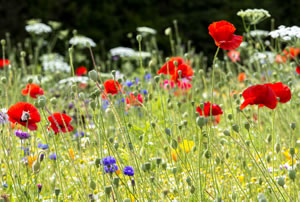CATTLE FED ON WILD FLOWERS COULD HELP SAVE DWINDLING MEADOWS
New study shows benefits of a switch to traditional farming, Marianne Brown reports.
Encouraging farmers to change from keeping cattle on conventional agriculturally improved pasture to grazing them on species-rich grassland could help save Britain’s meadows.
According to new research for the Save Our Magnificent Meadows campaign, the nutritional benefits of feeding cattle on wild-flower meadows could far outweigh those of feeding on conventional pasture, Trevor Dines from Plantlife, one of the organisations involved in the campaign, told Resurgence & Ecologist. Creating consumer demand for cattle fed this way would make it more financially viable for farmers to manage wild-flower meadows, and so protect them, Dines said.
Over 97% of wildflower meadows have disappeared in Britain since the 1930s, and this has in turn affected valuable insect populations.
With so few wild-flower meadows still around, people have lost touch with what it’s like to experience one, Dines said. “Sitting in a meadow, picking buttercups – that has disappeared from our landscapes,” he continued. “There’s nowhere else that’s as thrilling as a wild-flower meadow.”
To encourage interest in preserving wild-flower meadows, Plantlife organises the annual National Meadows Day, being held this year on 7 July. There will be bug hunts, butterfly identification, and the chance to run through a meadow “all senses firing”, as Dines puts it.
In the past, traditional meadows were allowed to grow from January to the beginning of August and were then cut for hay. This was followed by bare-field grazing livestock in September and October. Today’s highly managed farming techniques – silage fields are harvested two or three times a year – do not allow enough time for wild flowers to grow.
“Meadows get overlooked in the rewilding debate,” Dines said. “We’ve got fixations with woodland, but we need more balance because they do different things for different species.”
How can farmers protect wildflower meadows? Marianne Brown speaks to Audrey Compton, winner of the National Meadows Award, 2015, for our new podcast Resurgence Voices. resurgence.podiant.co
NEW WHALE SHARK HOTSPOT DISCOVERED IN MADAGASCAR
Tourism must be managed to protect the species, experts say. Melissa Hobson reports.
Madagascar is a feeding hotspot for juvenile whale sharks, according to a new study by the Madagascar Whale Shark Project (MWSP) published in the journal Endangered Species Research.
The research identified 85 individuals in the Nosy Be area during the September–December 2016 season. This compares to the 70 sharks identified in Tanzania and 33 in Mozambique (both globally renowned for their whale shark sightings) during the same year. The new findings could put Madagascar on the map for whale shark tourism.
MWSP, a collaboration between the Marine Megafauna Foundation, Florida International University and Mada Megafauna, was founded in 2016 by biologist Stella Diamant, lead author of the report. At that time, most scientists were unaware that there was a population of whale sharks in Madagascar, and locals estimated that there were only around 30 individuals. The MWSP team has since identified close to 250 individuals through photo identification, and has tracked movements of the species using satellite tags.
“We can now tell the world there are whale sharks here,” Diamant said. “Madagascar provides an important seasonal habitat for young sharks, so we need to ensure they are effectively protected.”
There are understandable concerns that any influx of tourists must be managed properly to ensure that the sharks are not negatively impacted. Diamant created a code of conduct outlining how to behave around the sharks, and has helped each of the local operators to implement it.
“When the operators understood the importance of the code of conduct and began to change their behaviours, it was really special,” she said. “If one boat was already with a shark in the water, all the others would wait rather than everyone trying to jump in at once. This meant the tourists had better interactions and nicer pictures and the sharks were not as bothered and stayed around for longer. It was great.”







